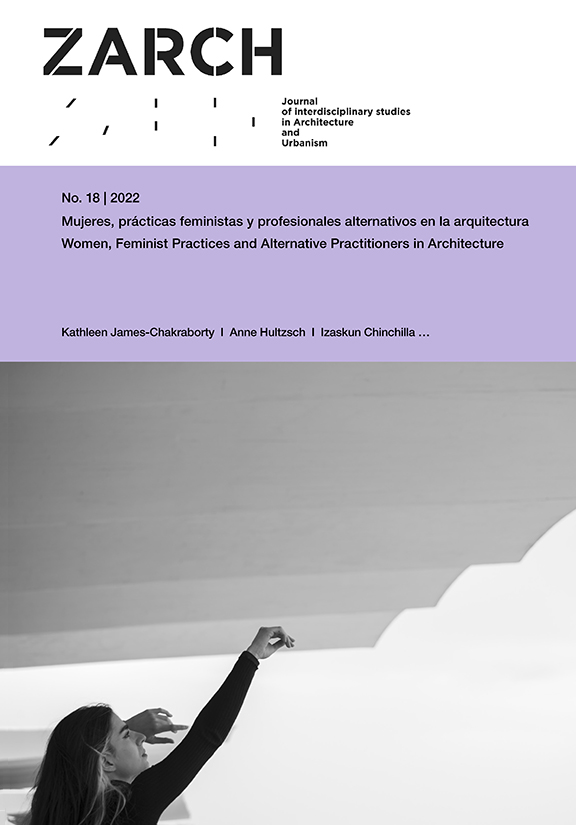Otras Prácticas: Historias de la arquitectura con perspectiva de género
DOI:
https://doi.org/10.26754/ojs_zarch/zarch.2022186968Palabras clave:
Mujeres arquitectas, Escritura femenina, Género, Profesionales alternativos, Prácticas feministas, HistoriografíaResumen
“Incorporar a las mujeres en la historia” es una frase comúnmente utilizada en el discurso feminista reciente. Cada vez son máslos académicos y académicas que trabajan para aumentar la visibilidad de las mujeres que lideraron de proyectos de diseño en el pasado reciente y no tan reciente. Estos esfuerzos, aunque esenciales, también son en cierta medida contraproducentes, debido al paradójico funcionamiento del privilegio: presentar a estas mujeres (y a otras figuras marginadas en la historia) como excepciones a la regla –como pioneras excéntricas– implica que la mayoría de sus contemporáneas (y otros de la comunidad negra, indígena, queer, etc...) no tuvieron ninguna influencia en las prácticas arquitectónicas occidentales y masculinas. Este artículo invitado sostiene que también debemos buscar otras prácticas que permitieron conseguir capacidad de acción a un mayor número mujeres (y a otros). La escritura es una de esas prácticas: dejar constancia de la experiencia, las críticas y las instrucciones para apropiarse de lo diseñado, atribuyendo significado a las arquitecturas y a los paisajes. Situar la capacidad de acción arquitectónica en una práctica que, aunque se asume cierto privilegio, estaba mucho más abierta a los grupos marginados que la arquitectura, nos permite mirar al pasado de forma más inclusiva y escribir historias con perspectiva de género que abran espacios para otros que también estuvieron allí.
Descargas
Referencias
Adams, Annmarie. Designing Women: Gender and the Architectural Profession. Toronto: University of Toronto Press, 2000.
Bohls, Elizabeth A. Women Travel Writers and the Language of Aesthetics, 1716-1818. Cambridge and New York: Cambridge University Press, 1995.
Brouwer, Petra, Christopher Drew Armstrong and Martin Bressani, ed. World Histories of Architecture. The Emergence of a New Genre in the Nineteenth Century. Cambridge, MA: MIT Press, 2022.
Gwendolyn Wright, “On the Fringe of the Profession,” in The Architect: Chapters in the History of the Profession, edited by Spiro Kostof, 280–309. Oxford: Oxford University Press, 1977.
Gunning, Sandra. Moving Home: Gender, Place, and Travel Writing in the Early Black Atlantic, Next Wave. Durham: Duke University Press, 2021.
Hinchcliffe, Tanis. “Women and the Practice of Architecture in Eighteenth-Century France,” in Architecture and the Politics of Gender in Early Modern Europe, edited by Helen Hills, 83ff. Aldershot: Routledge, 2003.
Hooks, bell. “Choosing the Margin as a Space for Radical Openness,” The Journal of Cinema and Media 36 (1989): 19.
Lefaivre, Liane and Alexander Tzonis, ed. The Emergence of Modern Architecture: A Documentary History, from 1000 to 1800. London: Routledge, 2004.
Lerner, Gerda. “Placing Women in History: Definitions and Challenges,” Feminist Studies 3, nº 1/2 (1975): 5-14. https://doi.org/10.2307/3518951.
Pollock, Griselda. Differencing the Canon: Feminist Desire and the Writing of Art”s Histories. London and New York: Routledge, 1999.
Roff, Shelley E. “Did Women Design or Build Before the Industrial Age?,” in The Routledge Companion to Women in Architecture, edited by Anna Sokolina, 21–31. New York: Routledge, 2021.
Scott, Joan Wallach. Gender and the Politics of History. New York: Columbia University Press, 1988.
Thompson, Carl. “Journeys to Authority: Reassessing Women”s Early Travel Writing, 1763–1862”, Women”s Writing 24, nº 2 (3 April 2017): 131–150. https://doi.org/10.1080/09699082.2016.1207915.
Willis, Julie. “Invisible Contributions: The Problem of History and Women Architects,” Architectural Theory Review 3, nº 2 (November 1998): 57-68. https://doi.org/10.1080/13264829809478345.
Woolf, Virginia, A Room of One’s Own. London: Penguin, 2004.





